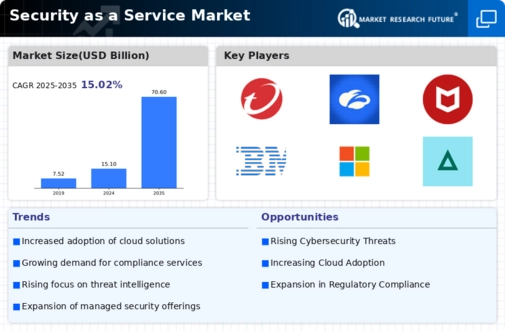-
Executive Summary
-
Scope Of The Report
-
Market Definition
-
Scope Of The Study
- Research Objectives
- Assumptions & Limitations
-
Markets Structure
-
Market Research Methodology
-
Research Process
-
Secondary Research
-
Primary Research
-
Forecast Model
-
Market Landscape
-
Porter’s Five Forces Analysis
- Threat Of New Entrants
- Bargaining Power Of Buyers
- Threat Of Substitutes
- Segment Rivalry
- Bargaining Power Of Suppliers
-
Value Chain/Supply Chain Of Security As A Service Market
-
Industry Overview Of Security As A Service Market
-
Introduction
-
Growth Drivers
-
Impact Analysis
-
Market Challenges
-
Market Trends
-
Introduction
-
Growth Trends
-
Impact Analysis
-
Security As A Service Market By Component
-
Introduction
-
Solution
- Market Estimates & Forecast, 2020-2027
- Market Estimates & Forecast By Region, 2020-2027
- Endpoint Protection
- Security Information And Event Management (SIEM)
- Identity Access Management (IAM)
- Intrusion Detection And Prevention Systems (IDS/IPS)
- Email Encryption
- Data Loss Prevention (DLP)
- Others
-
Service
- Market Estimates & Forecast, 2020-2027
- Market Estimates & Forecast By Region, 2020-2027
- Professional Services
- Managed Services
-
Security As A Service Market By Application Area
-
Introduction
-
Network Security
- Market Estimates & Forecast, 2020-2027
- Market Estimates & Forecast By Region, 2020-2027
-
Email Security
- Market Estimates & Forecast, 2020-2027
- Market Estimates & Forecast By Region, 2020-2027
-
Database Cloud Security
- Market Estimates & Forecast, 2020-2027
- Market Estimates & Forecast By Region, 2020-2027
-
Web Security
- Market Estimates & Forecast, 2020-2027
- Market Estimates & Forecast By Region, 2020-2027
-
Others
- Market Estimates & Forecast, 2020-2027
- Market Estimates & Forecast By Region, 2020-2027
-
Security As A Service Market By Organization Size
-
Introduction
-
Small And Medium-Sized Enterprises
- Market Estimates & Forecast, 2020-2027
- Market Estimates & Forecast By Region, 2020-2027
-
Large Enterprises
- Market Estimates & Forecast, 2020-2027
- Market Estimates & Forecast By Region, 2020-2027
-
Security As A Service Market By Vertical
-
Introduction
-
BFSI
- Market Estimates & Forecast, 2020-2027
- Market Estimates & Forecast By Region, 2020-2027
-
Oil And Gas
- Market Estimates & Forecast, 2020-2027
- Market Estimates & Forecast By Region, 2020-2027
-
IT And Telecom
- Market Estimates & Forecast, 2020-2027
- Market Estimates & Forecast By Region, 2020-2027
-
Retail
- Market Estimates & Forecast, 2020-2027
- Market Estimates & Forecast By Region, 2020-2027
-
Healthcare
- Market Estimates & Forecast, 2020-2027
- Market Estimates & Forecast By Region, 2020-2027
-
Government And Defense
- Market Estimates & Forecast, 2020-2027
- Market Estimates & Forecast By Region, 2020-2027
-
Others
- Market Estimates & Forecast, 2020-2027
- Market Estimates & Forecast By Region, 2020-2027
-
11.. Security As A Service Market By Region
-
Introduction
-
North America
- Market Estimates & Forecast, 2020-2027
- Market Estimates & Forecast By Component, 2020-2027
- Market Estimates & Forecast By Application Area, 2020-2027
- Market Estimates & Forecast By Organization Size, 2020-2027
- Market Estimates & Forecast By Vertical, 2020-2027
- US
- Canada
- Mexico
-
Europe
- Market Estimates & Forecast, 2020-2027
- Market Estimates & Forecast By Component, 2020-2027
- Market Estimates & Forecast By Application Area, 2020-2027
- Market Estimates & Forecast By Organization Size, 2020-2027
- Market Estimates & Forecast By Vertical, 2020-2027
- Germany
- France
- Italy
- Spain
- UK
-
Asia-Pacific
- Market Estimates & Forecast, 2020-2027
- Market Estimates & Forecast By Component, 2020-2027
- Market Estimates & Forecast By Application Area, 2020-2027
- Market Estimates & Forecast By Organization Size, 2020-2027
- Market Estimates & Forecast By Vertical, 2020-2027
- China
- India
- Japan
- Rest Of Asia-Pacific
-
Rest Of The World
- Market Estimates & Forecast, 2020-2027
- Market Estimates & Forecast By Component, 2020-2027
- Market Estimates & Forecast By Application Area, 2020-2027
- Market Estimates & Forecast By Organization Size, 2020-2027
- Market Estimates & Forecast By Vertical, 2020-2027
- Middle East & Africa
- Latin America
-
Company Landscape
-
Company Profiles
-
Symantec Corporation
- Company Overview
- Product/Business Segment Overview
- Financial Updates
- Key Developments
-
Intel Corporation
- Company Overview
- Product/Business Segment Overview
- Financial Updates
- Key Developments
-
Trend Micro Incorporated
- Company Overview
- Product/Business Segment Overview
- Financial Updates
- Key Developments
-
-
Cisco Systems Inc.
- Company Overview
- Product/Business Segment Overview
- Financial Updates
- Key Developments
-
Fortinet Inc.
- Company Overview
- Product/Business Segment Overview
- Financial Updates
- Key Developments
-
Panda Security
- Company Overview
- Product/Business Segment Overview
- Financial Updates
- Key Developments
-
CipherCloud
- Company Overview
- Product/Business Segment Overview
- Financial Updates
- Key Developments
-
Zscaler Inc.
- Company Overview
- Product/Business Segment Overview
- Financial Updates
- Key Developments
-
Alert Logic Inc.
- Company Overview
- Product/Business Segment Overview
- Financial Updates
- Key Developments
-
-
Radware Ltd
- Company Overview
- Product/Business Segment Overview
- Financial Updates
- Key Developments
-
Conclusion
-
List Of Tables
-
Global Security As A Service Market, By Region, 2020-2027
-
North America: Security As A Service Market, By Country, 2020-2027
-
Europe: Security As A Service Market, By Country, 2020-2027
-
Asia-Pacific: Security As A Service Market, By Country, 2020-2027
-
Rest Of The World: Security As A Service Market, By Country, 2020-2027
-
Global Security As A Service Type Market, By Component, 2020-2027
-
North America: Security As A Service Type Market, By Component, 2020-2027
-
Europe: Security As A Service Type Market, By Component, 2020-2027
-
Asia-Pacific: Security As A Service Type Market, By Component, 2020-2027
-
Table10 Rest Of The World: Security As A Service Type Market, By Component, 2020-2027
-
Table11 Global Security As A Service Application Market, By Application Area, 2020-2027
-
Table12 North America: Security As A Service Application Market, By Application Area, 2020-2027
-
Table13 Europe: Security As A Service Application Market, By Application Area, 2020-2027
-
Table14 Asia-Pacific: Security As A Service Application Market, By Application Area, 2020-2027
-
Table15 Rest Of The World: Security As A Service Application Market, By Application Area, 2020-2027
-
Table16 Global Security As A Service Application Market, By Organization Size, 2020-2027
-
Table17 North America: Security As A Service Application Market, By Organization Size, 2020-2027
-
Table18 Europe: Security As A Service Application Market, By Organization Size, 2020-2027
-
Table19 Asia-Pacific: Security As A Service Application Market, By Organization Size, 2020-2027
-
Table20 Rest Of The World: Security As A Service Application Market, By Organization Size, 2020-2027
-
Table21 Global Security As A Service Application Market, By Vertical, 2020-2027
-
Table22 North America: Security As A Service Application Market, By Vertical, 2020-2027
-
Table23 Europe: Security As A Service Application Market, By Vertical, 2020-2027
-
Table24 Asia-Pacific: Security As A Service Application Market, By Vertical, 2020-2027
-
Table25 Rest Of The World: Security As A Service Application Market, By Vertical, 2020-2027
-
Table26 Global Services Market, By Region, 2020-2027
-
Table27 North America: Intelligent Network Market, By Country
-
Table28 North America: Intelligent Network Market, By Component
-
Table29 North America: Intelligent Network Market, By Application Area
-
Table30 North America: Intelligent Network Market, By Organization Size
-
Table31 North America: Intelligent Network Market, By Vertical
-
LIST OF FIGURES
-
Global Security As A Service Market Segmentation
-
Forecast Methodology
-
Porter’s Five Forces Analysis Of Global Security As A Service Market
-
Value Chain Of Global Security As A Service Market
-
Share Of Security As A Service Market In 2020, By Country (In %)
-
Global Security As A Service Market, 2020-2027,
-
Global Security As A Service Market Size By Component, 2020-2027
-
Share Of Global Security As A Service Market By Component, (In %)
-
Global Security As A Service Market Size By Application Area, 2020-2027
-
Share Of Global Security As A Service Market By Application Area, (In %)
-
Global Security As A Service Market Size By Organization Size, 2020-2027
-
Share Of Global Security As A Service Market By Organization Size, (In %)
-
Global Security As A Service Market Size By Vertical, 2020-2027
-
Share Of Global Security As A Service Market By Vertical, (In %)


















Leave a Comment